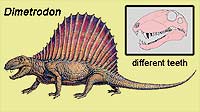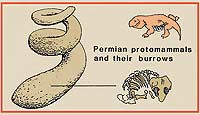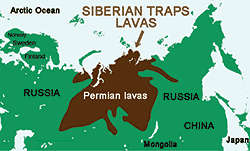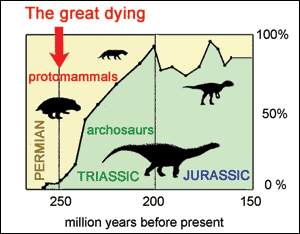PALEO HAPPENINGS March 2021 |
|||
| Surviving the Greatest Extinction: A Saga of Teeth, Ankles and Climate Change by Martin Lockley, Moab Giants |
|||
 You might be thinking, “dinosaur extinction!” No! There was another much greater extinction about 250 million years ago. It marked the transition between the Paleozoic Era of “ancient life” and the Mesozoic Era of “middle life,” also known as the P-T extinction or “great dying ” between the Permian and Triassic periods. The latest research indicates the extinction of more than 80% of all ocean life (some estimate 95%) and 75% of life on land. In contrast, the end Mesozoic extinction which did in the dinosaurs 65 million years ago, only killed half as many species. You might be thinking, “dinosaur extinction!” No! There was another much greater extinction about 250 million years ago. It marked the transition between the Paleozoic Era of “ancient life” and the Mesozoic Era of “middle life,” also known as the P-T extinction or “great dying ” between the Permian and Triassic periods. The latest research indicates the extinction of more than 80% of all ocean life (some estimate 95%) and 75% of life on land. In contrast, the end Mesozoic extinction which did in the dinosaurs 65 million years ago, only killed half as many species. So, the two big questions are what caused the extinction and which species survived or perished. Unlike the dinosaur extinction which killed pterosaurs, many large marine reptiles, ammonites and other groups, we cannot blame a sudden  meteorite impact. The favored theory of the great P-T extinction is volcanism. Massive eruptions of lava in Siberia covered an estimates 3 million square miles, an area the size of western Europe. Imagine the environmental impact, as gasses and aerosols blocked out sunlight, raising carbon dioxide levels and creating acid rain and acidification of the oceans. There is evidence that existing coal seams and large areas of forest burned off. Oceanic oxygen levels appear to have dropped, and it is likely that H2S (Hydrogen Sulfide) gas, with that rotten eggs smell, and methane were released to further pollute the atmosphere, raising temperatures up to 8°C. meteorite impact. The favored theory of the great P-T extinction is volcanism. Massive eruptions of lava in Siberia covered an estimates 3 million square miles, an area the size of western Europe. Imagine the environmental impact, as gasses and aerosols blocked out sunlight, raising carbon dioxide levels and creating acid rain and acidification of the oceans. There is evidence that existing coal seams and large areas of forest burned off. Oceanic oxygen levels appear to have dropped, and it is likely that H2S (Hydrogen Sulfide) gas, with that rotten eggs smell, and methane were released to further pollute the atmosphere, raising temperatures up to 8°C. Sensitive marine organisms like the abundant horn corals, found in the beautiful Hermosa sea described in last month’s issue (Happenings Feb 2021), went extinct, along with one of our paleontological favorites: the Trilobites. The brachiopods or lamp shells, also popular with collectors, were severely hit. Some underwent bizarre and unexplained anatomical change, as if experiencing last minute evolutionary contortions before going extinct.  On land our early protomammal ancestors included the famous fin backed reptile Dimetrodon (meaning different teeth). Another important ‘pre-extinction’ group the Cynodonts (meaning “wolf teeth”) began chewing their food to digest it more efficiently. Some forms also invented the “mammal underground,” living in burrows for safety, and to regulate their temperatures in harsh continental climates. They were probably the first vertebrates with hairy pelts, also good for insulation. Such Permian burrows and fossils are known from San Juan County Evolution worked on protomammal teeth, and jaws which also affected the evolution of the ear, close to the jaw hinge. Meanwhile, the story of a group known as the “archosaurs,” simply meaning “ancient reptiles,” involved improved ankles, hips and locomotion. Two major groups mammals and reptiles evolved differently before the great dying event, and their adaptations would be tested. Many of the immediate survivors were small, including protomammals ancestors of the first true mammals. This has been called the Lilliput effect, after the small  Lilliputian race in Gulliver’s Travels. But as we shall see in the next issue the Triassic was the “age of archosaurs,” with tribes of erect walking crocodiles, and bipedal proto-dinosaurs, that generally grew large as life recovered from the extinction. Some grew more like Gulliver’s giant Brobdingnagians. Our mammal ancestors were destined live patiently in the shadow of dinosaurs for more than 150 million years. But this is another story. Lilliputian race in Gulliver’s Travels. But as we shall see in the next issue the Triassic was the “age of archosaurs,” with tribes of erect walking crocodiles, and bipedal proto-dinosaurs, that generally grew large as life recovered from the extinction. Some grew more like Gulliver’s giant Brobdingnagians. Our mammal ancestors were destined live patiently in the shadow of dinosaurs for more than 150 million years. But this is another story. Widespread lava eruptions in Siberia caused climate change during the ‘great dying’ extinction crisis that marked the transition between the Permian and Triassic periods. The fin- or sail-backed Dimetrodon is often mistaken for a dinosaur, but it lived much earlier in the Early Permian. The sail was probably a heat regulating device Mammal ancestors (protomammals) became well established in the Permian Period. Some had hair and lived in burrows to help regulate their body temperatures in harsh continental climates. Protomammals, or mammal like reptiles were successful in the Permian, but were edged out in the Triassic “age of archosaurs.” Archosaurs evolved into three main groups: dinosaurs, pterosaurs and crocodiles. |